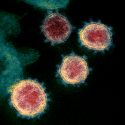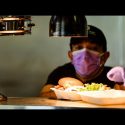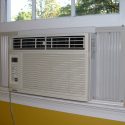COVID questions: Working out, disinfecting mail, neck gaiters
Editor’s note: We will be publishing answers to questions about COVID-19 and the pandemic each week in this COVID questions column. If you have a question, please email it to covid19update@uc.wisc.edu.
Q: A new study about neck gaiters mentions that the fabric used to make the face covering (typically polyester) can do more harm than good. Are the fabrics used for neck gaiters really worse than wearing no mask at all? What kind of fabric is the most effective in stopping the spread of the virus?
A: The most important part of a mask is its construction as well as the structure of the fabric. It’s best to have a mask with three layers and a tight structure. If you put a mask in front of a light and can recognize any shape or structure, the material is too light. It’s ok if you see a small amount of light so the mask remains breathable, but only very little light.
For the gaiter, it’s not the polyester that it’s made from that’s a concern. Many masks, including N95 and surgical masks, are made using polypropylene (a synthetic material made of plastic). Like polyester, polypropylene does not absorb moisture, so it can be very effective for masks. What’s problematic is that many masks, such as gaiters, are just one or two layers and the structure is too loose.
Any layer is better than nothing, but a thin layer can give you a false sense of security. The time and amount of exposure to the virus is important, so if you’re wearing a thin layer and are exposed to someone who has COVID, you’re more likely to be exposed.
If you have nothing available, gaiters are better than nothing. If you exercise social distancing, are being cautious, and are passing by someone quickly while wearing a gaiter and there is enough ventilation between you and the other person, you should be fine.
– Majid Sarmadi, Rothermel Bascom Professor, Textile Science, School of Human Ecology
Q: We continue to be very careful with any outside material entering home. E.g., we disinfect with alcohol all packed groceries. Is there any evidence of anyone being infected by a mail delivery or packed grocery without human contact in between?
A: Even as we continue to learn more about the coronavirus, the Centers for Disease Control and Prevention (CDC) says that the primarily spread is from person-to-person through respiratory droplets. While it may be possible that a person can get COVID-19 by touching a surface or object that has the virus on it and then touching the inside of the mouth or nose, or possibly their eyes, this is not thought to be the main way the virus spreads and there is no current evidence that transfer transmission does occur. Scientists do tell us that research results suggest that the coronavirus is considered to have poor survivability on surfaces.
Physical distancing remains the most important way in which we can help stop the spread of COVID-19. The second most important step is to frequently wash our hands, with soap and water for at least 20 seconds! In the unlikely event that you do come in contact with viable coronavirus particles on a surface, washing your hands will destroy the virus before you can transfer particles into your mouth or nose.
– Barbara Ingham, Professor, food science; food safety Extension Specialist
Q: Working out is very important to my son. At this point he has chosen to still stay in the dorms even though his classes will be online. However, that may be impacted if no workout facilities will be open. I understand there will be changes in how they open but can you assure us that the students will have access to these facilities?
A: The Shell and Nielsen Tennis Stadium (NTS) reopened to students, faculty, and staff on Monday, August 17. For the health and safety of our members and staff, facility occupancy will initially be limited to 25% and masks will be required at all times. Reservations are required for the Shell and NTS and can be made online.
The following in-person activities are available: cardio equipment, track, weight lifting, circuit work, stretching, and singles tennis. Other in-person programs and activities will become available when deemed safe. We are offering virtual programs like group fitness classes and Esports leagues.
The Nicholas Recreation Center is expected to open in a limited capacity on Monday, September 14. Upon opening, we anticipate that fitness and weight lifting spaces will be open for use. The pool will not be available. The opening of the Soderholm Family Aquatic Center is expected to be delayed until early to mid-October.
– University Recreation and Wellbeing. The opening announcement with hours of operation and complete safety guidelines can be found online here.
See more answers to COVID questions at https://news.wisc.edu/tag/covid-questions/. Also, visit our COVID-19 impact site.
Tags: COVID questions, covid-19, health & medicine



